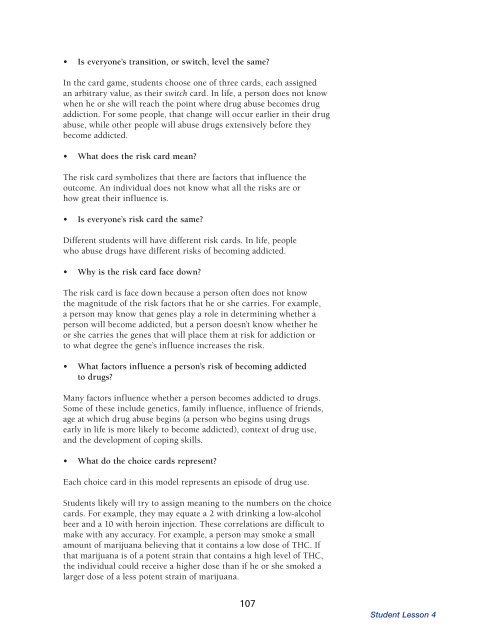Drug Abuse And Addiction - NIH Office of Science Education
Drug Abuse And Addiction - NIH Office of Science Education
Drug Abuse And Addiction - NIH Office of Science Education
You also want an ePaper? Increase the reach of your titles
YUMPU automatically turns print PDFs into web optimized ePapers that Google loves.
• Is everyone’s transition, or switch, level the same?In the card game, students choose one <strong>of</strong> three cards, each assignedan arbi trary value, as their switch card. In life, a person does not knowwhen he or she will reach the point where drug abuse becomes drugaddiction. For some people, that change will occur earlier in their drugabuse, while other people will abuse drugs extensively before theybecome addicted.• What does the risk card mean?The risk card symbolizes that there are factors that influence theoutcome. An individual does not know what all the risks are orhow great their influ ence is.• Is everyone’s risk card the same?Different students will have different risk cards. In life, peoplewho abuse drugs have different risks <strong>of</strong> becoming addicted.• Why is the risk card face down?The risk card is face down because a person <strong>of</strong>ten does not knowthe magnitude <strong>of</strong> the risk factors that he or she carries. For example,a person may know that genes play a role in determining whether aperson will become addicted, but a person doesn’t know whether heor she carries the genes that will place them at risk for addiction orto what degree the gene’s influence increases the risk.• What factors influence a person’s risk <strong>of</strong> becoming addictedto drugs?Many factors influence whether a person becomes addicted to drugs.Some <strong>of</strong> these include genetics, family influence, influence <strong>of</strong> friends,age at which drug abuse begins (a person who begins using drugsearly in life is more likely to become addicted), context <strong>of</strong> drug use,and the development <strong>of</strong> coping skills.• What do the choice cards represent?Each choice card in this model represents an episode <strong>of</strong> drug use.Students likely will try to assign meaning to the numbers on the choicecards. For example, they may equate a 2 with drinking a low-alcoholbeer and a 10 with heroin injection. These correlations are difficult tomake with any accuracy. For example, a person may smoke a smallamount <strong>of</strong> mari juana believing that it contains a low dose <strong>of</strong> THC. Ifthat marijuana is <strong>of</strong> a potent strain that contains a high level <strong>of</strong> THC,the individual could receive a higher dose than if he or she smoked alarger dose <strong>of</strong> a less potent strain <strong>of</strong> marijuana.107Student Lesson 4
















